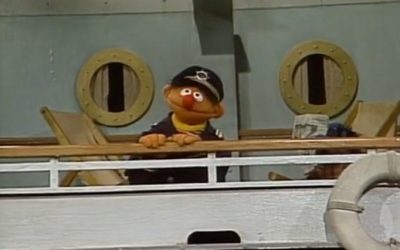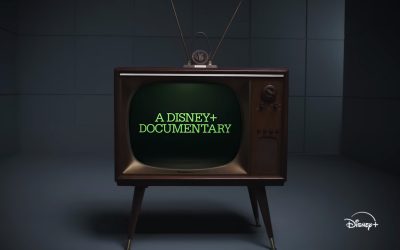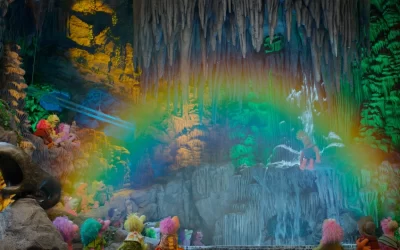Here at Tough Pigs, we’ve covered nearly every Christmas special Jim Henson and/or the Muppets ever made. But most of the non-holiday-related specials have been neglected until now. Each week, I’m joined by another Tough Pigs writer to watch a classic Muppet special that has nothing to do with Christmas.
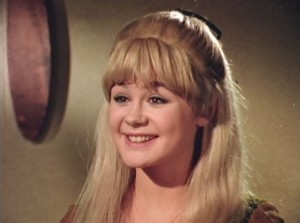 Anthony: This week we’re watching Jim Henson’s first hour-long Muppet TV special, Hey Cinderella. It’s from 1969, seven years after Tales of the Tinkerdee. This special is twice as long, it’s in color, it features human beings and actual songs, and it actually aired on television. Joining me to watch it is Tough Pigs co-owner Ryan Roe.
Anthony: This week we’re watching Jim Henson’s first hour-long Muppet TV special, Hey Cinderella. It’s from 1969, seven years after Tales of the Tinkerdee. This special is twice as long, it’s in color, it features human beings and actual songs, and it actually aired on television. Joining me to watch it is Tough Pigs co-owner Ryan Roe.
Ryan: Hey, that’s me! You know, it didn’t even occur to me that this was the first hour-long Muppet special. But it wasn’t always intended that way. As Muppet geeks know, it started life as a concept for a weekly Snow White series, before morphing into a pilot for a Cinderella series, and then this one-shot special.
Anthony: And what a special! Before I went into this project, I would have called this my favorite thing we’ll be covering in this series. Rewatching it didn’t change my mind. If anything, turning my critical faculties on made me even more impressed.
Ryan: It’s an impressive thing! Which kind of makes sense, considering the credits include names like Jim Henson, Jon Stone, and Joe Raposo.
Anthony: Working together for the first time! In retrospect, this plays like “just another project from the Sesame Street team,” but it’s the opposite of that. The collaboration started here and then carried over to a TV show that has outlived all three of them.
Ryan: We should also mention co-writer Tom Whedon, who was an early Sesame Street writer, as well as a sitcom veteran, and of course the dad of the guy who wrote and directed The Avengers. Whedon and Stone did some great work on this script, which feels exactly like Muppet comedy.
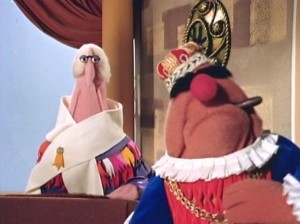 Anthony: Right, it’s clear that all of them have similar sensibilities. It’s so full of hilarious lines, but even more importantly, it’s set in a world where everyone has the same cracked logic.
Anthony: Right, it’s clear that all of them have similar sensibilities. It’s so full of hilarious lines, but even more importantly, it’s set in a world where everyone has the same cracked logic.
Ryan: The king (Goshposh, returning from Tinkerdee) consistently embodies that cracked logic. He has one of my favorite jokes in all of Muppet history: “Just because you’re royal doesn’t mean you have to be conceited. Why, look at me! One of the things that’s made me the greatest king in memory and a legend in my own time is a lack of conceit!”
Anthony: That’s a good one, but what really makes the world click, I think, is that everyone thinks like that. Even our straight characters – Cinderella and Prince Arthur – repeatedly say things like their “I didn’t go to school.”/“Neither did I! Maybe that’s where we met” exchange. Or the bit where Arthur tells Cinderella it’s early and she says “Early? I promised my step-mother I’d be home early!” Or the step-sisters’ insistence that they should get the King a pair of old socks as a gift because Cinderella wants a new hair ribbon, and she’s the opposite of the king, and old socks are the opposite of a new hair ribbon.
All of this stuff is taken at face value within the world of the story. It all operates in a remarkably consistent fashion. In a strange way, that bizarre approach makes everything feel more real.
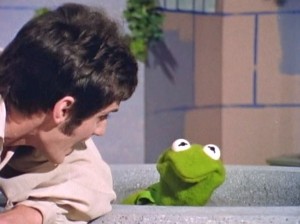 Ryan: It feels a bit ahead of its time in that way. There’s really not a character who realizes how silly all this is, although Kermit comes closest. He’s really dry and sardonic in this, especially compared to his later characterization.
Ryan: It feels a bit ahead of its time in that way. There’s really not a character who realizes how silly all this is, although Kermit comes closest. He’s really dry and sardonic in this, especially compared to his later characterization.
Anthony: Wisecracking would be a good word to describe him, but I think a lot of that is due to the sidekick role he plays here.
Ryan: He’s just a supporting character, for sure, but it’s interesting that Jim made the decision to cast him in the first place. Was he already thinking of Kermit as The Star of the Muppets?
Anthony: That’s something I was wondering – did they consider making this an original character like Fred the Elf from The Great Santa Claus Switch? In any case, Kermit’s definitely more detached here than he would be later on. It’s hard to imagine any later incarnation of Kermit shrugging off situations like he repeatedly does here. I feel like he’d be more invested in helping Arthur.
Ryan: Wow, I just realized Santa Claus Switch is one of the few Muppet specials Kermit doesn’t appear in. I suppose Ed Sullivan occupies Kermit’s traditional capacity as narrator, but with about 85% less charisma.
Anyway, Kermit isn’t as nice in Hey Cinderella as we’re used to him being, but that’s probably because he’s so bitter about being discriminated against because he’s a frog. Here’s a crazy interpretation I came up with while watching this with an eye toward discussing it: Is it possible that all the “NO FROGS ALLOWED” talk was influenced by the civil rights struggles that would have making headlines at the time? Or is that some absurd, Room 237-style overthinking?
Anthony: That hadn’t occurred to me – mostly because it’s all so light-hearted – but it’s certainly a possibility. That’s definitely what the Raposo-penned, Henson-performed “Bein’ Green” is about, after all, and that was just a year later. And the special does end with Kermit getting an invite to the wedding, although again, he’s so dispassionate about the events that he just tosses off a quick “Yeesh” about having to bring a gift for the King. So if it is a Civil Rights parallel, it’s one that falls apart at the end.
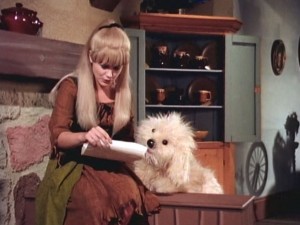 Ryan: “Yeesh” is not exactly an inspiring shout of triumph over adversity. Actually, Kermit says “Yeesh” a lot in this special. If you invented a Hey Cinderella drinking game, that would be a great opportunity to take a shot.
Ryan: “Yeesh” is not exactly an inspiring shout of triumph over adversity. Actually, Kermit says “Yeesh” a lot in this special. If you invented a Hey Cinderella drinking game, that would be a great opportunity to take a shot.
What about the other supporting Muppets? Rufus is a fun character who feels like the predecessor of Fraggle Rock’s Sprocket, and I’ve always found Splurge and his radish obsession hilarious. (And radishes were also a Fraggle Rock thing!)
Anthony: They’re both so great. I enjoy Rufus’s intro, where he excitedly washes dishes with his tongue. And I love everything about Splurge – not just the radish obsession, but his enormous-shaggy-carpet design and his chill, laid-back demeanor. There’s never been another Muppet quite like him – he always seems like he’s having a good time, whether he’s at the ball or just hanging around outside Cinderella’s house. I get the sense that he’s just happy to be alive.
Ryan: Happy to be alive, purple, and humongous.
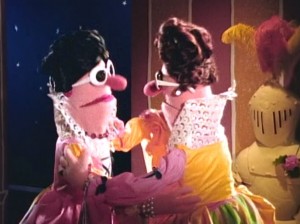 Anthony: The major Muppets we haven’t mentioned are Featherstone and the ugly step-daughters. The step-daughters are maybe a little bit too ugly, in the sense that the puppets look like they were thrown together at the last minute, but it’s fun to watch Jerry Nelson and Frank Oz bounce off of each other for one of the first times ever. I crack up at “My socks are older than your socks by a mile, dummy!”
Anthony: The major Muppets we haven’t mentioned are Featherstone and the ugly step-daughters. The step-daughters are maybe a little bit too ugly, in the sense that the puppets look like they were thrown together at the last minute, but it’s fun to watch Jerry Nelson and Frank Oz bounce off of each other for one of the first times ever. I crack up at “My socks are older than your socks by a mile, dummy!”
Ryan: The stepsisters are amusing in their brief appearances, but yeah, those puppets… As far as I could tell, Don Sahlin was the only person credited for building puppets, so maybe he was working so hard on Splurge that he really did run out of time to make the stepsisters look pretty. Er, pretty ugly.
Anthony: This special is the first time Jerry Nelson has really gotten to flex his character actor muscles, and Featherstone is the first in a series of a million memorable sidekicks. I love the contempt in his voice as he says “I suggest you look for the King. Where you find the King, I’m sure you’ll find the punch bowl.”
Ryan: One of my favorite things about this adaptation of Cinderella, which I probably never noticed when I saw it as a kid, is the way they switch things up by letting Cinderella and the prince get to know and like each other before the ball. It lets us root for them to get together in a way that makes more sense than Cinderella longing to be with a guy she’s never met.
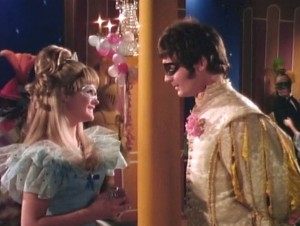 Anthony: Right, it’s a much more satisfying arc than the traditional story. They meet in the garden and form a connection based on their actual interactions – she falls in love with a gardener named Arthur, and he falls in love with a girl named Cinderella. They go to the ball looking for each other, but even better, they click again with their masks on. The entire arc is based on them getting along and having personalities that mesh. Even when he sees her in her ball gown at the end, he doesn’t comment on her appearance. He’s just happy to see her.
Anthony: Right, it’s a much more satisfying arc than the traditional story. They meet in the garden and form a connection based on their actual interactions – she falls in love with a gardener named Arthur, and he falls in love with a girl named Cinderella. They go to the ball looking for each other, but even better, they click again with their masks on. The entire arc is based on them getting along and having personalities that mesh. Even when he sees her in her ball gown at the end, he doesn’t comment on her appearance. He’s just happy to see her.
The best thing about this – the reason it works as a story – is because it isn’t presented as a “hilarious twist” like most stories of this type (Fractured Fairy Tales, Shrek, etc.) It’s just solid, character-based storytelling. Henson and his team trust the audience enough to assume that we all know the original story and don’t need the differences pointed out. They just confidently stroll in and give us a much better version of it.
Ryan: And a better-than-average romantic comedy! And the human actors are all pretty perfectly cast. Belinda Montgomery is so charming, and Robin Ward is totally believable as the humble, nice-guy heir to the throne.
Anthony: Agreed on both counts. I completely buy that they click. They seem to be having a lot of fun together.
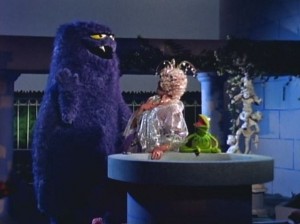 Ryan: Well, wouldn’t you be having fun with Splurge as your co-star?
Ryan: Well, wouldn’t you be having fun with Splurge as your co-star?
Anthony: Who do you think Belinda Montgomery had more fun with – Splurge or her Doogie Howser son Neil Patrick Harris? Do you think he ever pestered her with questions about working with the Muppets?
Ryan: Given how big a Muppet geek we now know him to be, I wouldn’t be surprised. Of course, in those days he was a slightly smaller Muppet geek.
Anthony: While Montgomery and Ward (Ha! Like the store!) are low-key and charming, Pat Galloway as the step-mother goes in a different direction. She’s over-the-top in the best way – flitting through scenes with a haughty expression, looking down her nose at everything around her, squeaking out her condescending lines with an obnoxious sneer. She’s a blast. And as my wife pointed out when we watched, she even looks a bit like a Muppet with that bright red hair.
Ryan: Either that or a close relative of Ronald McDonald! Her theatrical performance is exactly what it needs to be. I also like Joyce Gordon as the fairy godmother, who really wants to be a good magic-person but knows her limitations.
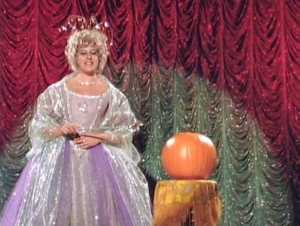 Anthony: The Fairy Godmother is the one element that doesn’t quite work for me. I never thought I would find occasion to the use the phrase “a cut-rate Kaye Ballard,” but that’s what Gordon reminds me of here. Gordon is broad, but not in a fun way. Mostly I just want to tell her take it down a bit. I’d much rather have seen someone like Ballard or Ruth Buzzi, who would have struck a similar tone but not been as aggressively “WACKY!”
Anthony: The Fairy Godmother is the one element that doesn’t quite work for me. I never thought I would find occasion to the use the phrase “a cut-rate Kaye Ballard,” but that’s what Gordon reminds me of here. Gordon is broad, but not in a fun way. Mostly I just want to tell her take it down a bit. I’d much rather have seen someone like Ballard or Ruth Buzzi, who would have struck a similar tone but not been as aggressively “WACKY!”
That said, the Fairy Godmother also gets most of the worst jokes. Her stage cutaways in the first act seem like filler to me – I always forget they exist until another one pops up – and her references to other stories like Pinocchio and the Wizard of Oz are just that: references without much creativity or humor.
Ryan: Aw, she makes me chuckle. And I’m willing to be lenient on the references, considering this was decades before our current age of comedy, where entire TV series are built on nothing but cultural references.
Anthony: Sure. She doesn’t ruin the special for me, and a lot of her stuff works just fine. But she’s my least-favorite note in a production where I adore everything else.
Ryan: Okay, but see if she ever shows up to help you out when you’re sitting there crying about misplacing your Blu-ray of The Great Muppet Caper.
You mentioned “songs” in your intro, but is there really a full-fledged musical number besides “If I Could Go Dancing?” Which, by the way, I find oddly spooky with its haunted music-box arrangement.
Anthony: To answer your first point, there are two songs – the other being the opening “Here in the heart of the lo-o-ow rent district, stands the castle of the King” thing, which is a lot smaller scale, but still counts, I think.
Ryan: Is that what they’re saying? I could never make those words out! But I am a big fan of “Once upon a time/Once upon a time/Very long ago/Could it be last Thursday?”
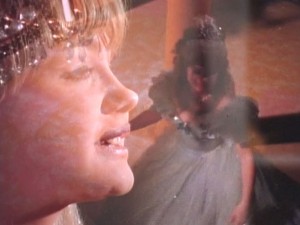 Anthony: Anyway, I can see that about the arrangement of “If I Could Go Dancing.” Mostly, that song just seems like it’s from a different, much straighter version of Cinderella. It even gives her a line about dancing with the Prince like that’s her goal. It isn’t. Dancing with Arthur is her goal.
Anthony: Anyway, I can see that about the arrangement of “If I Could Go Dancing.” Mostly, that song just seems like it’s from a different, much straighter version of Cinderella. It even gives her a line about dancing with the Prince like that’s her goal. It isn’t. Dancing with Arthur is her goal.
Ryan: Plus, she says her dress would be white, but when she actually does go dancing, her dress is light blue! Obviously the fairy godmother didn’t hear the song.
Anthony: Obviously not! Another thing that I really love are the sets. They’re a natural evolution from the paper backdrops of Tales of the Tinkerdee – a perfect blend of storybook and realistic. The Courtyard, for example, has a cardboard background with three-dimensional plants and dirt in front of it.
Ryan: It has an appealing, handmade feel, like a colorful live theater production.
Anthony: Especially noteworthy is the throne room in the palace, which has a remarkable sense of depth despite being made of cardboard. There’s a scene towards the beginning where Arthur runs out the room to tell Cinderella she’s invited to the ball, and we see him run through a whole other room in the background before he goes outside. He could have just walked off-camera, but little touches like that make the environments feel real.
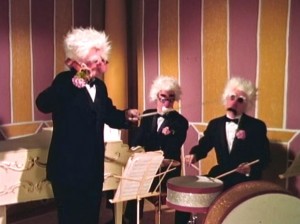 Ryan: I’ll tell you what doesn’t feel real, but I love it anyway: the Muppet heads of the three-man orchestra at the ball! I crack up every time the camera cuts back to those guys, often playing instruments that have nothing to do with the music we’re actually hearing in the ballroom. And I’d bet five dollars that they were at least partially inspired by Ernie Kovacs’s Nairobi Trio.
Ryan: I’ll tell you what doesn’t feel real, but I love it anyway: the Muppet heads of the three-man orchestra at the ball! I crack up every time the camera cuts back to those guys, often playing instruments that have nothing to do with the music we’re actually hearing in the ballroom. And I’d bet five dollars that they were at least partially inspired by Ernie Kovacs’s Nairobi Trio.
Anthony: That seems likely! It’s certainly nice to see Jim Henson trying new things like that. In general, the ball sequence is a marvel from beginning to end.
Ryan: It’s obviously the model for The Muppet Show’s “At the Dance” sketches, so we have it to thank for that.
Anthony: Right! But it’s so much more than that. It cuts between three tones – situation-based jokes with Goshposh and Featherstone, the semi-serious development of Cinderella and Arthur’s relationship, and the ridiculous At-the-Dance-style jokes with the other characters – and it balances all three of them really well.
Really, I think it’s a key point in Jim’s development as a director. He’d never done anything with as much heart as the Cinderella/Arthur relationship. Tinkerdee, Sam & Friends, and his variety show sketches were mostly just jokes, and “Time Piece” is an experimental film with no real characters. So this is the first time he’s asking us to invest in a romantic relationship, and even here he has the good sense to constantly balance it out with jokes. A lot of jokes. Different types of jokes.
That blend of comedy first and then heart second, hiding among the laughs, is what makes the Muppets so special, and this is the first time we really get to see it.
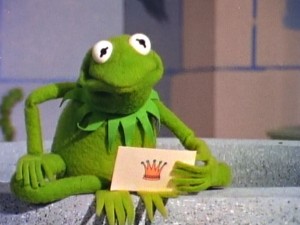 Ryan: It’s an important development, for sure. And all in a special originally sponsored by R.J. Reynolds Tobacco. Yeesh.
Ryan: It’s an important development, for sure. And all in a special originally sponsored by R.J. Reynolds Tobacco. Yeesh.
Anthony: Yeesh is right!
Well, that just about covers it. Thanks so much for joining me, Ryan!
Ryan: Any time, Anthony! It’s always a pleasure to watch Muppet things and then talk about them. Hey, do you have any radishes?
Anthony: No, but I got you a back-scratcher because I know you don’t have one.
Ryan: Thanks! You can marry my son now.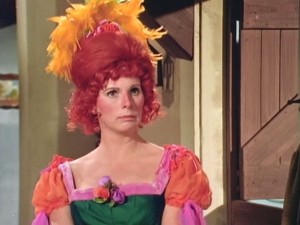
Next: Roz Strand (oh hey, that’s the person I’m actually married to!) joins me for popovers while we watch 1971’s “The Frog Prince.”
Click here to wear a geranium on the Tough Pigs Forum.
by Anthony Strand and Ryan Roe

